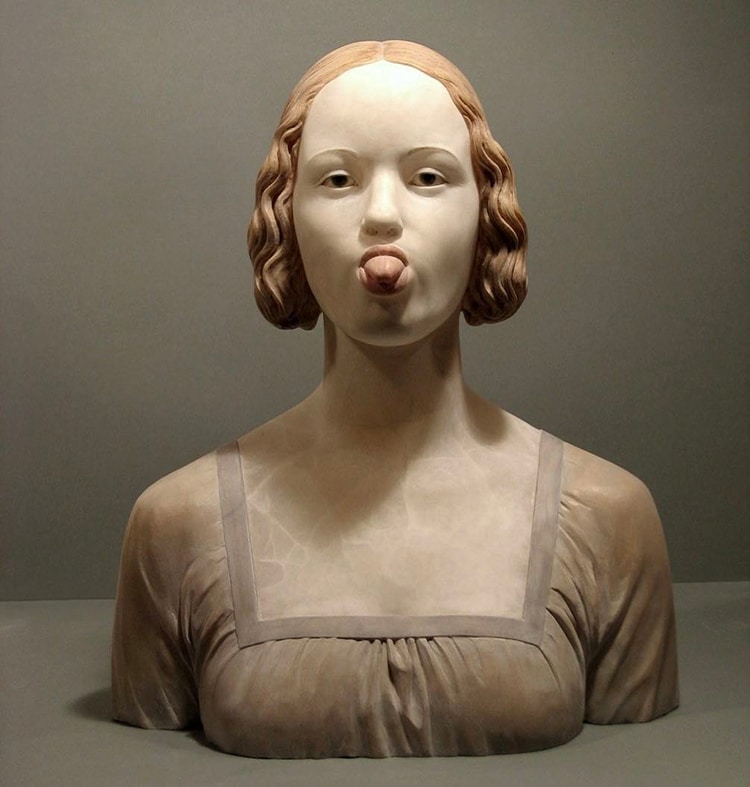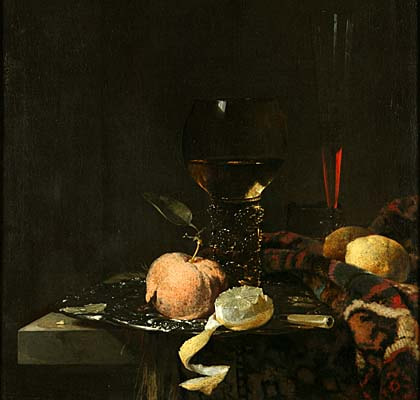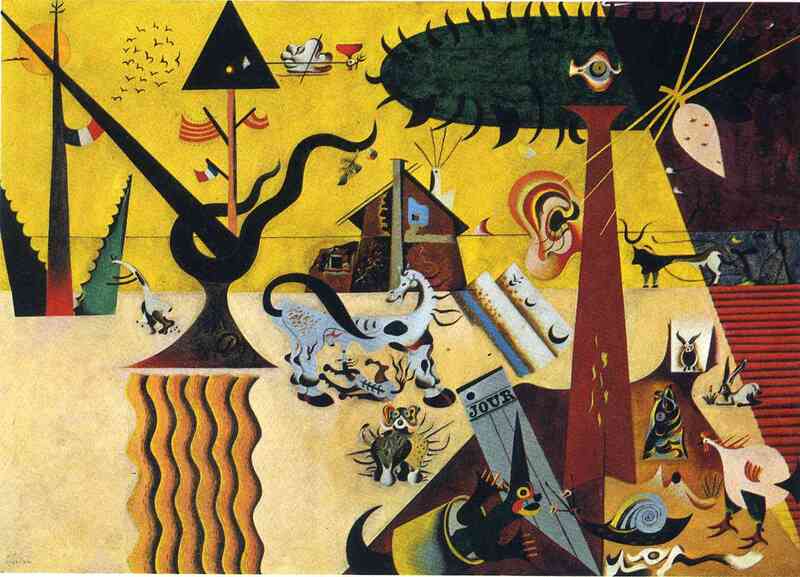|
Task 2 connects with Threshold Concept 2. It is an opportunity to consider how artworks communicate with us and each other, across time and space - but not always through language or logic.
You will complete: 1. a sequence of specific instructions to reveal an artwork - to be used for critical analysis and creative experimentation. (suggested time: approx 2 hours). 2. a practical re-imagining of this (randomly generated) artwork (approx 2-4 hours). |
|
Chance became our trademark. We followed it like a compass.
HANS RICHTER
It's probably worth emphasising that this initial exercise is embracing 'chance'. It is something that artists do often, for example, to generate a starting point (as we are doing); through various means of delegating or relinquishing control; through embracing unpredictable methods of mark making. 'Chance' in art is often considered a Surrealist notion, but it might be suggested that since art's prehistoric beginnings - when humans first blew paint from their mouths, for example - chance has always been at play.
|
Follow the instructions below carefully:
Example: My first word 'reflective' was typed in the search bar and 'Artworks' were searched. My second word 'Seagull' has 7 letters. This results in an Edward Weston photograph, Shells, 1927, being my potential starting point. |
ACTIVITY PART 1: CRITICAL ANALYSIS
Our focus here is on how art 'communicates'. When we choose to look at art, for example in a book, on an Instagram feed or visiting a gallery, we will instinctively spend longer with some works rather than others. This makes an artwork generated by chance particularly beneficial for the exercise that will follow. We might choose to pay increased attention because some artworks are 'eye-catching', provoke curiosity, have appealing subject matter; we might see something we recognise within an artwork, perhaps of ourselves or of our own lives. Yet beyond the obvious - personal tastes, appeals and interests - how we encounter artworks can also be greatly influenced by more subtle factors, for example, what else lies in close proximity; who we are with; our own moods, feelings and experiences in those surrounding moments of time. How art communicates with us (or others - or other things, even) is not fixed but always subject to change.
Consider your generated artwork carefully and respond to all the following prompts:
Consider your generated artwork carefully and respond to all the following prompts:
- Beyond the immediately visual, which senses might the artwork also (potentially) communicate with? How might an encounter with the artwork in real-life differ from this on-screen introduction? Consider scale, media and how the artwork has been shared (recorded, photographed, re-presented and contextualised by accompanying information).
- Without over-thinking your answers: which sounds, tastes, smells or textures might you imaginatively connect or associate with the work? How about if the artwork was a person, an animal, a building or an(other) object? What about something more abstract or obscure - a religion, a facial expression, a weather condition? How might imaginative and metaphorical connections help to express how an artwork communicates with us and/or impacts upon us?
|
- Research your artwork/artist in more depth. Depending on the work and its subject matter, media used, title, date etc. you might investigate wider themes.
REMEMBER: RESEARCH DOESN'T HAVE TO BE A CLINIcal fact copying exercise. aim to also compare, contrast, connect and categorise your findings with your own experiences and perspectives.
ACTIVITY PART 2: RE-IMAGINING; RE-INTERPRETING
- Use the artwork as a starting point to produce your own practical response, on your own terms.
- This is an opportunity to use the media you wish and work in a style of your own choosing - to re-imagine/re-interpret the work (or a section or associated aspect of it).
- Carefully consider what/how/to whom your response might 'communicate'. Which senses will your artwork 'speak to'? How might the viewer experience or interact with your response? How might your response connect or contrast with your starting artwork?
- If the starting point - your selected artwork - has very limited appeal, do not be constrained by this. Be liberated. This is an opportunity to develop, adapt, appropriate, select from, eliminate... to challenge what you do not like.
TASK 2 ADDITIONAL RESOURCES
Below are a small selection of examples where artists, for various reasons, have responded to existing artworks. Some of these couplings are immediately obvious, others are quite distinct in media, style and/or appearance. Some artists might be driven to respond through respect and admiration, others might be motivated to challenge, subvert, entertain, or simply benefit by association. Research the names and titles below the works to find out more.
Kara Walker's Fons Americanus, 2019 (right) questions narratives of power and explores the interconnected histories of Africa, America and Europe. She uses water as a key theme, referring to the transatlantic slave trade and the ambitions, fates and tragedies of people from these three continents. The work takes inspiration from a wide range of sources including John Singleton Copley's, Watson and the Shark, 1778 (left).
Battleship Potemkin (1925) is a film by Russian director, Sergei Eisenstein (film still on left). The work was a profound influence on artist Francis Bacon who frequently referenced this in his own screaming figures, most directly 'Study for the Nurse in the film 'Battleship Potemkin', 1957.
Gerard Mas (right) creates playful works inspired by 15th Century portraits such as this Portrait of Giovanna Tornabuoni by Domenico Ghirlandaio (left).
Sherrie Levine’s “La Fortune” (After Man Ray), (right) is an installation consisting of 6 re-imagined pool tables which refers to a late Surrealist painting by Man Ray entitled La Fortune, 1938 (left).
Cornelia Parker's Landscape with Gun and Tree (right) is both a response to her own fascination with weapons and a homage to Thomas Gainsborough's Mr and Mrs Andrew, 1750 (left).
Mat Collishaw's 'Last Meal on Death Row, Texas', 2011 (right) is a series of photos of prisoners' final meal requests. These are photographed in the style of a 17th Century Dutch Still Life, such as by Willem Kalf (left).
'The Garden of Earthy Delights' (1490-1510) is a triptych painting by Hieronymus Bosch (left) which greatly influenced 1923 Joan Miró's 'The Tilled Field' a view of his family’s farm in Montroig, Catalonia.
Jeff Wall's 'The Destroyed Room',1978 (right) is a contemporary photographic response to 'The Death of Sardanapalus', 1827 by Eugène Delacroix, which depicts the Assyrian monarch on his deathbed, commanding the destruction of his possessions and slaughter of his concubines.
TASK 2 SUMMARY
- You should have completed and documented the initial 'chance' exercise as a means to generate an artwork as a starting point. This should be evident in notes, screenshots and/or playful sketches.
- You should also have completed 'Activity Part 1: Critical Analysis'. This might also include wider research and experimental sketches in response to the artist examples, above.
- These activities and research should now inform your own creative response to the allocated artwork. This should also say something about the styles/techniques/media/methods of working that you are particularly interested in exploring further.





















